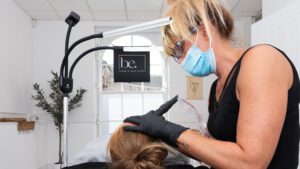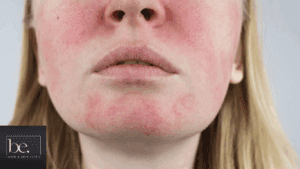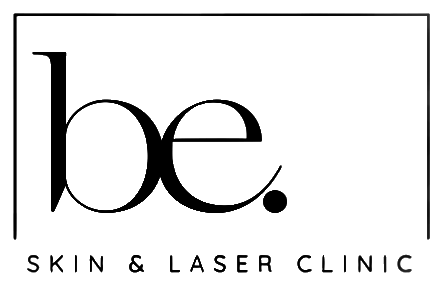If you’ve ever battled hair that just won’t quit because of PCOS, you know the drill: endless shaving, painful waxing and still seeing stubble pop up the next day. That’s where PCOS laser treatment comes in. It targets the root so you spend less time fussing over hair and more time doing things you actually enjoy. Below, you’ll find a simple outline of how it works, what to do before your sessions and how to keep your skin happy once you’ve wrapped up your last visit.
Key Takeaways
- Laser targets hair follicles for longer relief compared to shaving or waxing
- Simple prep steps—like avoiding sun and skipping plucking—make sessions safer
- Regular follow-ups with PCOS laser treatment help keep any regrowth in check
.
Understanding Why PCOS Laser Treatment Works
How Laser Targets Hormonal Hair Growth
Right, so PCOS can cause some pretty annoying hormonal imbalances, leading to excess hair growth where you really don’t want it. Think of laser hair removal as a high-tech targeting system. It zeroes in on those pesky hair follicles using concentrated light. The pigment in the hair absorbs the light, which then damages the follicle, slowing down future growth. It’s not a one-shot deal, mind you, but with each session, you’re weakening those follicles.
Laser hair removal is effective because it directly addresses the root cause of the problem – the hair follicle itself. Unlike shaving or waxing, which only provide temporary fixes, laser treatment offers a more lasting solution by disrupting the hair growth cycle
Benefits over Traditional Hair Removal
Okay, let’s be real, we’ve all been there with the shaving rash and the ingrown hairs from waxing. Not fun! Laser hair removal offers a bunch of advantages over those old-school methods. For starters:
- It’s way more precise, targeting only the hair follicles without messing with the surrounding skin. Laser hair removal is a game changer.
- It gives you longer-lasting results. We’re talking weeks, months, or even years of smooth skin, compared to the daily grind of shaving.
- It can actually reduce hair thickness and density over time. So, even if some hairs do grow back, they’re often finer and less noticeable.
.
Plus, think about the time you’ll save! No more frantic shaving before a night out. Here’s a quick comparison:
| Method | Pros | Cons |
|---|---|---|
| Shaving | Quick, cheap | Temporary, can cause irritation |
| Waxing | Longer-lasting than shaving | Painful, can cause ingrown hairs |
| Laser Treatment | Long-term reduction, precise, time-saving | Requires multiple sessions, initial cost higher |
Preparing for Your Laser Sessions
Alright, so you’re thinking about laser hair removal for your PCOS-related hair growth? Ace decision! But before you jump in, there’s a bit of prep work to make sure you get the best results and avoid any unwanted surprises. Think of it like prepping a canvas before painting – a smooth start leads to a masterpiece!
Customising Treatment to Your Skin and Hair
First things first, not all skin and hair are created equal, especially when PCOS is involved. That’s why a proper consultation is essential. The technician needs to assess your skin type, hair colour, and thickness to tailor the laser settings. This isn’t a one-size-fits-all situation, and customisation is key to both effectiveness and safety. They’ll likely ask about your medical history, any medications you’re taking, and previous hair removal methods you’ve tried. Be honest and upfront – it’s all about getting the best possible outcome for you. For example, someone with darker skin might need a different laser type or lower settings to prevent pigmentation changes. It’s also worth discussing your expectations. Laser hair removal can significantly reduce hair growth, but it might not eliminate it completely, especially with hormonal conditions like PCOS. Realistic expectations are important for satisfaction.
Essential Pre-treatment Guidelines
Okay, now for the nitty-gritty. There are a few things you absolutely MUST do (and NOT do) in the weeks leading up to your laser sessions. Think of these as the golden rules for laser success:
- Avoid sun exposure like the plague. Seriously, tanning or sunburn can seriously mess with the treatment and increase the risk of skin damage. If you’ve been sunbathing, reschedule your appointment. This is super important. You might want to consider laser hair removal in winter.
- Ditch the waxing, plucking, and threading. Laser hair removal targets the hair follicle, so it needs to be present. These methods remove the follicle, rendering the laser useless. Shaving is fine, though – in fact, you’ll need to shave the area 1-2 days before your appointment.
- Hold off on certain skincare products. Retinoids, glycolic acid, salicylic acid – these are all great for your skin normally, but they can make it more sensitive to laser treatment. Stop using them at least a week or two beforehand.
- Shave the area. Shave the area to be treated 1-2 days before your appointment. This ensures the laser can effectively target the hair follicle without interference from surface hair.
- Skip the lotions, makeup, and deodorant on the day of your appointment. Clean skin is happy skin (and happy laser results!).
.
It’s also a good idea to wear loose, comfortable clothing to your appointment. This will help minimise any irritation after the treatment. And don’t be afraid to ask questions! Your technician should be happy to explain the process and address any concerns you might have.
Following these guidelines will set you up for a smoother, safer, and more effective laser hair removal experience. Trust me, a little preparation goes a long way!
Achieving Lasting Results with PCOS Laser Treatment

So, you’ve started your laser hair removal journey – brilliant! But how do you make sure those results actually last, especially when PCOS is in the mix? It’s not just about the sessions themselves; it’s about what you do afterwards too. Let’s get into it.
Managing Maintenance and Follow-ups
Laser hair removal is amazing, but it’s not a one-and-done deal, especially with PCOS. Hormonal fluctuations can still trigger some hair growth, so think of it more like long-term management. Maintenance sessions are key to keeping unwanted hair at bay.
- Stick to the schedule your technician recommends. They’ll know best when you need a top-up.
- Don’t be afraid to book extra sessions if you notice new growth popping up. It’s better to tackle it early.
- Keep an eye on any changes in your PCOS symptoms. If things are flaring up, it might affect hair growth.
.
It’s worth considering a clinic that offers a guarantee, like the GoLaser Guarantee. This can give you peace of mind knowing you’ll have access to the sessions you need without unexpected costs.
Monitoring Skin Health Post-treatment
Your skin might be a little sensitive after laser sessions, so treat it with care. Think gentle, gentle, gentle!
- Avoid harsh scrubs or exfoliants for a few days after treatment.
- Slather on the moisturiser to keep your skin hydrated.
- Always wear sunscreen, even on cloudy days. Laser treatment can make your skin more sensitive to the sun.
.
And if you notice anything unusual – like excessive redness, blistering, or changes in pigmentation – get in touch with your clinic straight away. It’s always better to be safe than sorry. Laser hair removal offers a long-term solution for managing unwanted hair growth, but it requires commitment and proper aftercare. Stick with it, and you’ll be enjoying smoother skin for ages!
PCOS often means extra hair that just won’t go away. Our laser sessions zap it fast, are mostly pain-free and need only a few visits. You’ll see lasting results and feel more confident. Visit our website to book your free chat today.
Conclusion
Alright, I know PCOS hair can feel like a never-ending battle. Laser hair removal isn’t a quick fix, but it does cut down the constant shaving and waxing grind. After a handful of sessions you’ll spot less regrowth and spend way less time in front of the mirror. Sure, you might book in a top-up here and there, but it beats daily upkeep. And with the GoLaser Guarantee—unlimited sessions for two years plus a free touch-up—you get peace of mind and steady results. If you’re over the usual hair-removal hustle, laser could be just the relief you’ve been waiting for.
Start a PCOS plan → Confidence Packages
Frequently Asked Questions
How does laser hair removal work for PCOS hair growth?
Laser hair removal uses gentle bursts of light to zap the hair follicle at its root. Over several sessions, it weakens the follicle so hair grows back thinner and slower. It’s far more lasting than shaving or waxing.
Is laser hair removal safe if I have PCOS?
Yes, it’s generally safe. You might feel a light prick or warmth during the session. Your skin can go a bit red afterwards, but that usually settles in a few hours. Just make sure you see a trained therapist and follow the before-and-after tips.
How many sessions will I need to see real results?
Most people book around six to eight treatments spaced about four to six weeks apart. With PCOS you might need an extra couple of sessions or yearly top-ups to keep hair at bay. Once you’re done, only occasional maintenance is needed.





